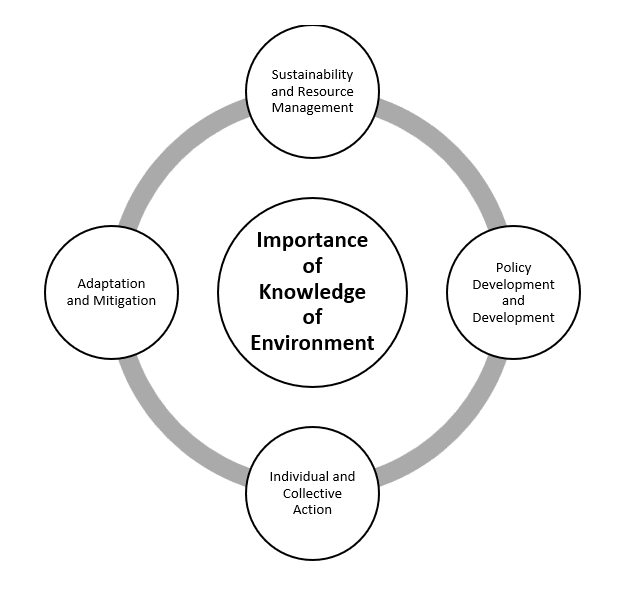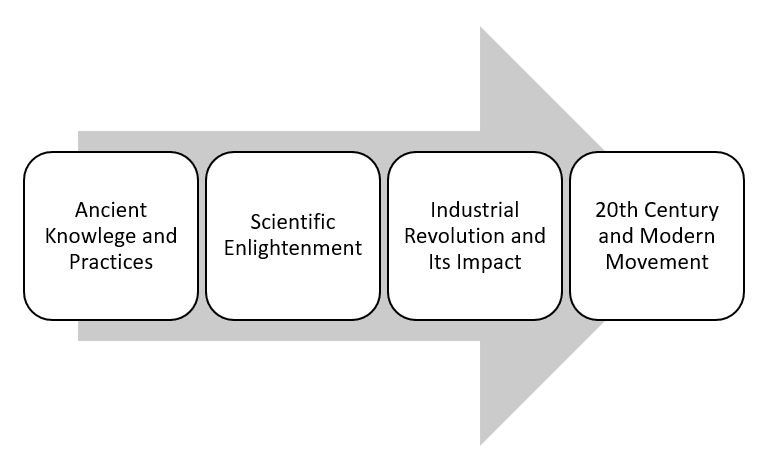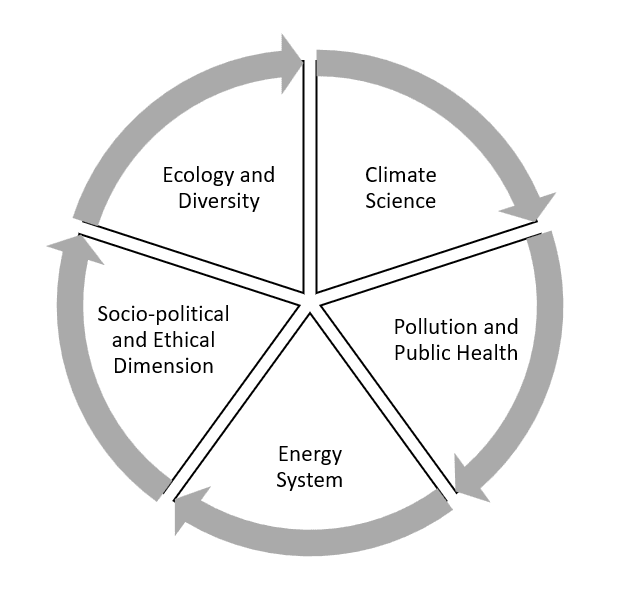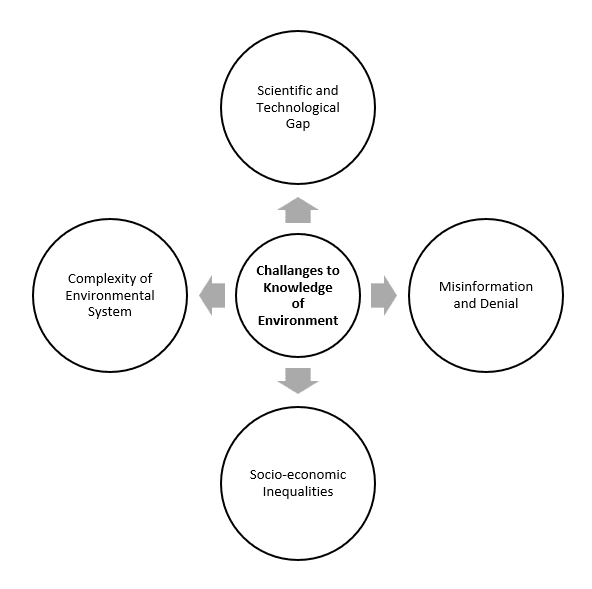Introduction
The environment is a complex and dynamic system comprising all living (biotic) and non-living (abiotic) elements that interact to sustain life on Earth. Knowledge of the environment refers to understanding these interactions, the ecological balance they create, and the human impacts on this equilibrium. As global challenges such as climate change, pollution, and deforestation intensify, the need for informed environmental stewardship becomes more urgent.
Importance of Knowledge of the Environment
Knowledge of enviornment is important because it can help us with the following-

Importance of Knowledge of Environment
- Sustainability and Resource Management- Sustainability depends on the ability to balance resource use with ecological preservation. Knowledge about the carrying capacity of ecosystems helps societies avoid overexploitation. For instance, studies on water scarcity in arid regions guide strategies for efficient water use (UNEP, 2019).
- Policy Development and Governance- Environmental policies require accurate scientific data to be effective. Regulations on emissions, waste disposal, and conservation depend on environmental monitoring. For example, the Paris Agreement targets greenhouse gas reductions based on scientific findings (IPCC, 2021).
- Individual and Collective Action- Awareness drives behavior change. Individuals who understand the impact of single-use plastics or fossil fuel consumption are more likely to adopt sustainable practices, such as using renewable energy or participating in recycling programs.
- Adaptation and Mitigation- With rising sea levels, extreme weather, and other climate-induced phenomena, environmental knowledge helps communities adapt and mitigate damage. For example, urban planning informed by flood risk data can prevent disasters.
Read More- What is Sustainability?
Historical Perspectives
Environmental knowlege was discovered differently across different time period, this includes-

Historical Perspective
- Ancient Knowledge and Practices- Indigenous communities around the world have long practiced sustainable living. Examples include rotational farming, water conservation methods like India’s stepwells, and the Polynesians’ navigation techniques that respected marine ecosystems (Gadgil et al., 1993).
- Scientific Enlightenment- The 17th century marked a transition to systematic environmental study. Alexander von Humboldt’s work emphasized the interconnectedness of ecosystems, a precursor to modern ecological science (Wulf, 2015).
- Industrial Revolution and Its Impact- The Industrial Revolution disrupted the harmony between humans and the environment. Industrial waste and urban sprawl created unprecedented challenges, sparking the beginnings of conservationist movements, such as those led by John Muir and Gifford Pinchot in the United States.
- 20th Century and Modern Movements- The publication of Rachel Carson’s Silent Spring (1962) was a turning point in environmental awareness. Global initiatives such as Earth Day (1970) and the establishment of the United Nations Environment Programme (UNEP) institutionalized environmental action (Carson, 1962; UNEP, 2020).
Dimensions of Environmental Knowledge
There are different dimensions of environmental knowledge, these includes-

Dimensions of Knowledge of Environment
- Ecology and Biodiversity- Understanding ecosystems, biodiversity, and their intricate networks is fundamental. Ecological balance supports vital services such as pollination, carbon sequestration, and water purification. Loss of biodiversity, as seen in the deforestation of the Amazon, jeopardizes these services (CBD, 2020).
- Climate Science- Knowledge of the Earth’s climate system is crucial for addressing global warming. Key concepts include the greenhouse effect, carbon footprint, and climate resilience. Scientific models predict the effects of rising CO₂ levels, helping nations plan for mitigation (IPCC, 2021).
- Pollution and Public Health- Environmental knowledge extends to pollution control. For instance, understanding the health impacts of air pollutants like particulate matter (PM2.5) informs regulations on vehicular emissions. Similarly, marine pollution studies guide policies on plastic waste management.
- Energy Systems- The transition to renewable energy sources—solar, wind, and hydro—is essential for sustainability. Knowledge of energy efficiency and the environmental costs of fossil fuels drives innovation and adoption of clean technologies.
- Sociopolitical and Ethical Dimensions- Environmental justice addresses inequities where marginalized communities bear the brunt of environmental degradation. Legal frameworks like the Aarhus Convention empower public participation in environmental decisions (UNECE, 1998).
Challenges to Environmental Knowledge
There are various challanges to knowledge of environment, these include-

Challanges to Knowledge of Environment
- Scientific and Technological Gaps- Environmental research is often limited by funding, technology, and access to remote areas. For example, insufficient data on deep-sea ecosystems hampers efforts to protect marine biodiversity (NOAA, 2021).
- Misinformation and Denial- Misinformation campaigns fueled by vested interests obscure scientific truths about climate change, delaying action (Oreskes & Conway, 2010).
- Socioeconomic Inequalities- In low-income regions, poverty and lack of education restrict access to environmental information and sustainable technologies. Bridging these gaps is crucial for global progress.
- Complexity of Environmental Systems- The non-linear and interconnected nature of ecological processes makes predicting outcomes challenging. For instance, the cascading effects of species extinction often remain poorly understood.
Case Studies
The importance of knowlege of environment can be understood using three important case studies, these includes-
- The Ozone Layer Recovery- The Montreal Protocol (1987), which phased out ozone-depleting substances like CFCs, highlights how science-driven policies can reverse environmental harm. Satellite data show significant ozone recovery over Antarctica (UNEP, 2020).
- Community-Led Conservation in Kenya- Kenya’s Maasai Mara region demonstrates the success of integrating traditional knowledge with modern conservation strategies. Community-managed conservancies have preserved wildlife habitats while promoting eco-tourism (Mwangi et al., 2016).
- Germany’s Energy Transition- Germany’s Energiewende initiative showcases the application of environmental knowledge in transitioning to renewable energy sources, achieving a reduction in greenhouse gas emissions by over 25% since 1990 (BMWK, 2021).
Knowledge of Environment Glossary
Some important terms to understand in terms of knowlege of environment includes-
- Biodiversity- According to the Convention on Biological Diversity (CBD), biodiversity is “the variability among living organisms from all sources, including terrestrial, marine, and other aquatic ecosystems and the ecological complexes of which they are part.” Biodiversity encompasses the diversity of species, genetic variations within species, and ecosystems. It is essential for maintaining ecosystem resilience and providing ecosystem services, such as food production, climate regulation, and disease control. Declining biodiversity undermines these services, threatening human well-being. For example- the Amazon Rainforest, often called the “lungs of the Earth,” contains an estimated 10% of the world’s species, including jaguars, toucans, and countless insects (CBD, 2020).
- Carbon Footprint- According to Wiedmann and Minx (2008), the carbon footprint is “a measure of the total amount of carbon dioxide and methane emissions directly and indirectly caused by an activity or accumulated over the life stages of a product.” The carbon footprint quantifies the impact of human activities on global warming by measuring greenhouse gas emissions. Activities such as driving fossil fuel-powered vehicles, deforestation, and manufacturing contribute significantly to carbon footprints. Reducing carbon footprints is critical for mitigating climate change. For example- a person driving a gasoline car for 20,000 kilometers per year emits approximately 4.6 metric tons of CO₂, contributing to their annual carbon footprint (IPCC, 2021).
- Carrying Capacity- According to Rees (1992), carrying capacity refers to “the maximum number of individuals or species an environment can support indefinitely without degrading the resources and ecosystem upon which it depends.” Carrying capacity depends on factors such as resource availability, environmental conditions, and species-specific needs. When populations exceed carrying capacity, ecosystems may experience resource depletion, habitat degradation, and population decline. For example- overgrazing by livestock in sub-Saharan Africa has led to desertification, exceeding the region’s carrying capacity for sustainable agriculture (FAO, 2020).
- Deforestation- The United Nations Food and Agriculture Organization (FAO) defines deforestation as “the conversion of forest to other land uses, whether human-induced or not.” Deforestation results in habitat loss, reduced carbon sequestration, and disruption of water cycles. It is driven by agricultural expansion, logging, and infrastructure development. Efforts to combat deforestation include reforestation projects and stricter land-use policies. For example- between 2001 and 2020, Brazil lost over 59 million hectares of forest, mainly due to agricultural activities like cattle ranching (WWF, 2021).
- Ecology- Eugene Odum (1963), a pioneer in the field, defined ecology as “the study of the structure and function of nature, focusing on the interactions between living organisms and their environments.” Ecology explores how organisms interact with each other and their surroundings, including biotic and abiotic factors. This field is critical for understanding the balance of ecosystems and the impacts of human activity on natural processes. For example- coral reef ecology studies reveal how symbiotic relationships between coral and algae are disrupted by rising sea temperatures, leading to coral bleaching (Hughes et al., 2017).
- Ecological Literacy- David Orr (1992) defines ecological literacy as “the ability to understand the principles of ecosystem organization and sustainability, enabling informed decisions about human actions.” Ecological literacy equips individuals with knowledge to live sustainably and address environmental challenges. It emphasizes the interconnectedness of natural systems and human activities. Schools and communities are increasingly integrating ecological education into curricula. For example- programs like Earthwatch’s citizen science initiatives foster ecological literacy by engaging participants in hands-on environmental research (Earthwatch Institute, 2021).
- Ecosystem Services- According to the Millennium Ecosystem Assessment (2005), ecosystem services are “the benefits people obtain from ecosystems, categorized as provisioning, regulating, cultural, and supporting services.” These services include essential functions such as pollination, water purification, and nutrient cycling. Loss of ecosystem services due to degradation has far-reaching implications for food security, health, and economic stability. For example- wetlands provide flood regulation and water filtration services, protecting nearby communities from disasters and ensuring clean water supplies (Barbier et al., 2011).
- Greenhouse Effect- The Intergovernmental Panel on Climate Change (IPCC) describes the greenhouse effect as “the trapping of heat in the Earth’s atmosphere due to the presence of greenhouse gases, which absorb and emit infrared radiation.” This natural phenomenon maintains Earth’s temperature within a range suitable for life. However, human activities, such as burning fossil fuels and deforestation, have intensified the greenhouse effect, leading to global warming. For example- atmospheric CO₂ levels increased from 280 ppm (pre-industrial era) to over 415 ppm in 2021, amplifying the greenhouse effect (IPCC, 2021).
- Habitat- According to Smith and Smith (2012), a habitat is “the natural environment in which an organism lives, including all biotic and abiotic factors necessary for its survival and reproduction.” Habitats vary greatly, from terrestrial forests to aquatic coral reefs. Habitat destruction caused by urbanization, agriculture, and climate change poses a significant threat to biodiversity. Protecting habitats is a cornerstone of conservation efforts. For example- mangrove forests serve as habitats for diverse species, including fish and crustaceans, while also acting as carbon sinks (Barbier et al., 2011).
- Keystone Species- Paine (1969) coined the term keystone species to describe “a species that has a disproportionately large effect on its ecosystem relative to its abundance.” Keystone species are vital for maintaining ecological balance. Their removal can trigger trophic cascades, leading to ecosystem collapse. Conservation efforts often prioritize keystone species to ensure ecosystem stability. For example- sea otters in kelp forests control sea urchin populations. Without otters, unchecked sea urchins devastate kelp beds, disrupting the entire ecosystem (Estes et al., 2011).
- Renewable Energy- The International Renewable Energy Agency (IRENA) defines renewable energy as “energy derived from natural sources that are replenished at a higher rate than they are consumed.” Renewable energy sources, including solar, wind, hydro, and geothermal, play a pivotal role in reducing dependence on fossil fuels and mitigating climate change. Adoption of renewable energy is supported by technological advancements and policy incentives. For example- Denmark generates nearly 50% of its electricity from wind power, exemplifying the successful integration of renewable energy into national grids (IRENA, 2022).
- Sustainability- The Brundtland Commission (1987) defines sustainability as “meeting the needs of the present without compromising the ability of future generations to meet their own needs.” Sustainability is a multidisciplinary approach involving economic, social, and environmental dimensions. It promotes resource efficiency, renewable energy adoption, and waste reduction to achieve long-term ecological balance. For example- sustainable agriculture practices, such as crop rotation and organic farming, help maintain soil fertility and reduce environmental impact (FAO, 2020).
- Urban Sprawl- According to the Urban Land Institute (2011), urban sprawl is “the expansion of urban areas into rural or natural land, characterized by low-density, automobile-dependent development.” Urban sprawl often leads to habitat destruction, increased carbon emissions, and loss of agricultural land. Planning strategies like smart growth aim to counteract its negative impacts by promoting compact, transit-oriented development. For example- Los Angeles is a classic example of urban sprawl, where extensive suburban development has encroached on natural habitats, affecting biodiversity and air quality (Angel et al., 2011).
Conclusion
Environmental knowledge is essential for addressing the multifaceted challenges facing humanity today. From understanding biodiversity and climate science to implementing effective policies and technologies, informed decision-making at every level is key to sustainability. However, significant barriers such as misinformation, inequities, and data limitations must be addressed.
By investing in education, fostering global collaboration, and integrating traditional knowledge with modern science, we can build a future where human progress harmonizes with ecological preservation. The journey towards a sustainable world begins with informed awareness and collective action.
References
Angel, S., et al. (2011). Making Room for a Planet of Cities. Lincoln Institute of Land Policy.
Barbier, E. B., Hacker, S. D., Kennedy, C., Koch, E. W., Stier, A. C., & Silliman, B. R. (2011). “The value of estuarine and coastal ecosystem services.” Ecological Monographs, 81(2), 169-193.
Carson, R. (1962). Silent Spring. Houghton Mifflin.
CBD. (2020). Convention on Biological Diversity. Global Biodiversity Outlook 5. Retrieved from https://www.cbd.int/
Earthwatch Institute. (2021). “Citizen Science and Environmental Education.” Retrieved from https://earthwatch.org/
Estes, J. A., et al. (2011). “Trophic Downgrading of Planet Earth.” Science, 333(6040), 301-306.
FAO. (2020). The State of the World’s Forests 2020. Food and Agriculture Organization of the United Nations.
Gadgil, M., Berkes, F., & Folke, C. (1993). “Indigenous knowledge for biodiversity conservation.” Ambio, 22(2-3), 151-156.
Hughes, T. P., et al. (2017). “Coral reefs in the Anthropocene.” Nature, 546, 82–90.
IPCC. (2021). Sixth Assessment Report. Intergovernmental Panel on Climate Change.
IRENA. (2022). Renewable Energy: A Key to Sustainable Development. International Renewable Energy Agency. Retrieved from https://www.irena.org/
Millennium Ecosystem Assessment. (2005). Ecosystems and Human Well-being: Synthesis. Island Press.
Mwangi, E., et al. (2016). “Community-Based Natural Resource Management in Kenya.” Ecology and Society, 21(2), 3.
NOAA. (2021). “Deep-Sea Exploration and Biodiversity.” National Oceanic and Atmospheric Administration. Retrieved from https://www.noaa.gov/
Oreskes, N., & Conway, E. M. (2010). Merchants of Doubt: How a Handful of Scientists Obscured the Truth on Issues from Tobacco Smoke to Global Warming. Bloomsbury Press.
Paine, R. T. (1969). “A Note on Trophic Complexity and Community Stability.” The American Naturalist, 103(929), 91-93.
Rees, W. E. (1992). “Ecological Footprints and Appropriated Carrying Capacity: What Urban Economics Leaves Out.” Environment and Urbanization, 4(2), 121-130.
Smith, T. M., & Smith, R. L. (2012). Elements of Ecology. Pearson Education.
UNECE. (1998). The Aarhus Convention. United Nations Economic Commission for Europe.
UNEP. (2019). Global Environmental Outlook 6. United Nations Environment Programme.
UNEP. (2020). Emissions Gap Report. United Nations Environment Programme.
Urban Land Institute. (2011). Land Use and Driving: The Role Compact Development Can Play in Reducing Greenhouse Gas Emissions. ULI.
Wiedmann, T., & Minx, J. (2008). “A Definition of ‘Carbon Footprint’.” Ecological Economics Research Trends, 1, 1-11.
Wulf, A. (2015). The Invention of Nature: Alexander von Humboldt’s New World. Knopf.
WWF. (2021). Deforestation and Forest Degradation. World Wildlife Fund. Retrieved from https://www.worldwildlife.org/
Subscribe to Careershodh
Get the latest updates and insights.
Join 13,999 other subscribers!
Niwlikar, B. A. (2024, December 29). Knowledge of the Environment and 13 Important Terms. Careershodh. https://www.careershodh.com/knowledge-of-the-environment/
